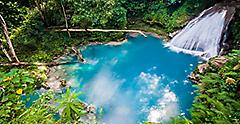Discover Jammin’ Jamaican Dishes And Popular Caribbean Delicacies
By Eben Diskin | Published on March 22, 2022
The iconic travel destination of Jamaica is most commonly associated with its pristine beaches, waterfalls, reggae, and of course, rum. However, unless you've tasted its cuisine for yourself, you might not know about the island's delicious food scene. From Jamaican oxtails to curried goat and jerk chicken, Jamaican dishes are some of the most flavorful in the entire Caribbean.

Jamaican cuisine is defined by a cultural fusion of African, European, Chinese, Indian and indigenous Taino influences that have made their way to the island over the past few centuries. The Spanish and British colonization of Jamaica in the 16th and 17th centuries led to the importation of African slaves, followed by Indian and Chinese laborers who brought their own cooking techniques to Jamaica that blended with indigenous customs. This resulted in a truly multicultural culinary tradition that continues to this day.
From a breakfast of codfish fritters to a lunch of flaky beef patties and a dinner of curried goat or Jamaican oxtails, your culinary experience in Jamaica will be unlike any other in the Caribbean. These are the most delectable Jamaican dishes as well as a few of the best-known restaurants to visit during your next vacation cruise to Jamaica.
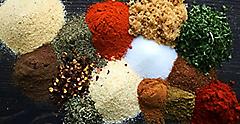
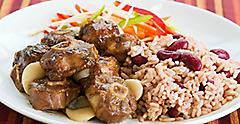
Authentic Jamaican Oxtails Are A One-of-a-kind Dish
Despite its name, oxtails aren't necessarily the tail of an ox. Traditionally, the popular Jamaican dish was always made with an actual ox tail, but nowadays, it can be the tail of a male or female cow. Jamaican oxtails are cow tails that have been skinned and cut into sections, with each section consisting of a tailbone with marrow and gelatinous meat in the middle. The composition of oxtails makes them particularly well-suited to soups, stocks and braises. Originally, oxtail was largely eaten only by impoverished families due to its affordability and high fat content, but the dish has now achieved delicacy status, becoming a staple of Jamaican cuisine enjoyed by all.
Oxtail stew is made by seasoning the oxtail with brown sugar, salt, black pepper, garlic powder, allspice, soy sauce, Worcestershire sauce, then browning the meat before either pressure or slow cooking it in beef broth. An assortment of vegetables like yellow and green onions, carrots, garlic, turnips, cabbage, green beans and lima beans are then usually added.
Braised oxtails involve searing the oxtails in hot oil and boiling them with garlic, onions and spices. The brown gravy is made using bacon grease, broth from the oxtails and flour. The oxtails are then mixed with the gravy in a skillet and cooked for several minutes before serving over rice.
Where To Eat Oxtails In Jamaica
One of the best restaurants to find Jamaican oxtail is at Miss T's Kitchen in Ocho Rios. Miss T's Famous Oxtail is simmered with carrots, butter beans and "spinners" (dumplings).
Address: Miss T's Kitchen, 65 Main St, Ocho Rios, Jamaica
Curried Goat Is A Cultural Crossover Recipe
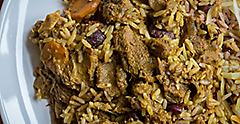
Curried goat probably sounds more like a cuisine you'd find in India than one of Jamaica's most popular dishes, but it's the perfect example of the island's cross-cultural culinary tradition. It came to the island courtesy of the East Indian laborers who were indentured servants on Jamaica in the mid-1800s.
As it sounds, curried goat is a curry dish made from goat meat. The meat is seasoned with spices, including garlic, ginger, thyme, onions, hot pepper and curry, then marinated with a dry rub. Slow-cooking the goat meat results in a dish that's incredibly tender and juicy. It's typically served with rice and peas — another classic Jamaican dish.
Where To Eat Curried Goat In JamaIca
The historic Devon House Mansion in Kingston is one of the best (and most opulent) places to find curried goat in Jamaica. Formerly belonging to George Stiebel, Jamaica's first black millionaire, the mansion's servant quarters have been converted into shops and restaurants. One of those restaurants is the Grog Shoppe, which serves curried goat with rice and peas in a beautiful outdoor setting surrounded by palm trees.
Address: Grog Shoppe Restaurant, 26, 10 Hope Rd, Kingston, Jamaica
Jerk Chicken Is A Native Caribbean Staple For A Reason
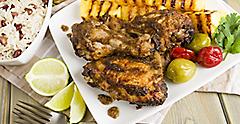
Jerk chicken has transcended Jamaica's culinary scene and become a common staple of Caribbean-inspired menus around the world. The indigenous Taino people of Jamaica developed the cooking method, then passed it along to the African slaves who were brought to the island by its colonizers.
"Jerk" cooking isn't a reference to particularly arrogant chefs. It's a cooking style in which the meat — often chicken, pork, beef, or seafood — is covered in spices and slow-cooked over a fire or grill, infused with flavor from the smoke. The word "jerk" actually has roots in the Spanish word "charqui," which means dried strips of meat. Although jerk chicken varies throughout the Caribbean, in Jamaica, it's known for its strong marinade and incorporation of Scotch bonnet peppers usually served with rice, beans, plantains and cornbread fritters. If you like it spicy, jerk chicken is for you.
Where To Eat Jerk Chicken In Jamaica
Scotchies is widely considered to be the best place for jerk chicken in Jamaica. This rustic restaurant is defined by its thatched roof, barrel chairs and open kitchen where you can actually watch the chefs smoke your chicken. The original Scotchies is in Kingston, but there are also two other locations in Ocho Rios and Montego Bay.
Address: Scotchies, Rose Hall Main Rd., Montego Bay, Jamaica
Enjoy A Traditional Jamaican Breakfast Of Ackee And Saltfish
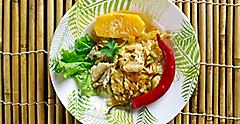
It's not a traditional breakfast in Jamaica without a plate of the island's national dish: ackee and saltfish. Though ackee is Jamaica's national fruit, it actually originates in West Africa and was brought to the Caribbean in the 1700s. Now, it can be found almost everywhere, from supermarkets to street vendors and even trees along the roadside. The fruit is red on the outside with yellow flesh on the inside, which is boiled before eating. Ackee also has large dark seeds that are toxic and can't be consumed.
Paired with ackee for this breakfast dish is yet another import from abroad. Saltfish originates in the seas of Northern Europe and can be made by preparing, drying and salting any kind of whitefish. Saltfish was introduced to the Caribbean in the 17th century via trade between northern Europe, Africa and the Americas.
The dish is prepared by soaking the saltfish to remove the excess salt, then cutting up and combining with pre-boiled ackee. The saltfish and ackee are then sauteed with onions, tomatoes and scotch bonnet peppers, and served alongside other breakfast staples such as breadfruit and bacon.
Where To Eat Ackee And Saltfish In Jamaica
On the western tip of Jamaica, you'll find Murphy's West End Restaurant serving up homemade food, coconut water and beer under a thatched roof. Their ackee and saltfish breakfast comes with fried dumplings called Johnnycakes, another fixture of the Jamaican breakfast plate.
Address: Murphy's West End Restaurant, Lighthouse Rd., Negril, Jamaica
Jamaican Beef Patty Is The Perfect Quick Lunch Idea

No, it's not a burger beef patty between two buns that Americans are familiar with. A Jamaican beef patty looks more like an empanada and consists of a spicy beef filling baked inside a flaky, golden-brown pastry shell. The special not-so-secret ingredient is the scotch bonnet pepper, which really gives the patties their signature spicy kick.
Jamaican beef patties combine the pastries brought by Cornish immigrants and the cayenne, curry and cumin spices brought by Indian laborers and African slaves. As one of the most popular Jamaican dishes, it has also become popular in British cities such as London and Manchester, which have large Indian populations.
Where To Eat Local Beef Patties In Jamaica
Sometimes, it's best to keep it simple. Beef patties aren't meant to be consumed on white tablecloths or washed down with a bottle of aged wine; they're meant to be enjoyed with your hands on the go as you explore the island. Juici Patties is the largest fast-food chain in Jamaica with over 60 locations, and as its name suggests, it specializes in the classic Jamaican patty. If you're not into beef, you can also get shrimp, chicken, vegetable, ackee or soy varieties.
Address: Lot 1, Clarendon Park, May Pen, Jamaica






